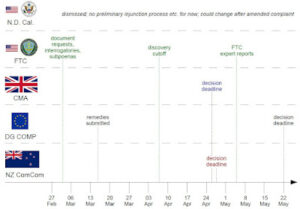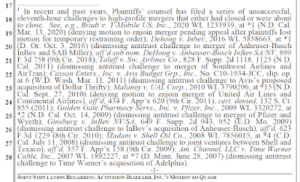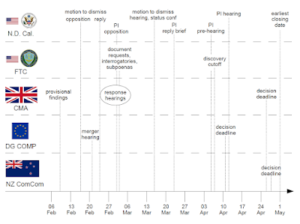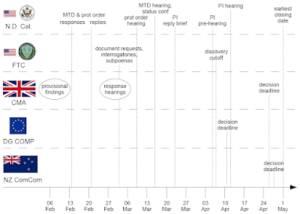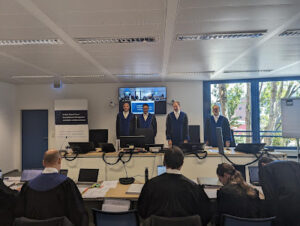At this week's Warsaw conference on standard-essential patents (SEPs), Professor Jorge Contreras (Utah)--who is generally in favor of the proposed EU SEP Regulation, which I attribute to his well-known preference for softer SEP enforcement rather than unbiased analysis of the bill's incurable flaws--criticized one major loophole: the draft regulation doesn't cover standard-essential utility models.
That is indeed a loophole, and quite a big one. The version that leaked in late March actually defined SEP in a way that explicitly also covered utility models (SEUMs), which are registered--but not examined--property rights covering technical inventions and available in certain jurisdictions, particularly Germany, but also Spain and Italy. The current proposal does not pertain to SEUMs.
SEUMs are not just a hypothetical possibility. They do exist and actually get enforced. In December 2018, I attended a SEUM trial in Munich, where the defendants were represented by Professor Peter Chrocziel (one of the best patent litigators Germany ever had; at the time of that SEUM trial, he was a Bardehle Pagenberg partner, and now running his own IP and antitrust law boutique in Munich, focusing on strategic advice).
If the EU SEP Regulation entered into force, contributors to standards could easily work around it by obtaining German utility models and enforcing those, without enforcement being delayed or the commercial terms being impacted by the envisioned FRAND rate determinations. German national courts would presumably apply the Sisvel v. Haier standard, but that is--relatively speaking--the best a defendant to a SEUM assertion could hope for.
Utility models come with two key limitations. One is that they will be enforceable for only 10 years, not 20, from the priority date. The other is that there is no presumption of validity, so the hurdle for defendants seeking a stay pending a parallel validity determination is rather low. However, if there already is some case law relating to a patent based on the same original invention, or if there is no reasonably strong invalidity argument, German courts will order injunctions. And in Spain, it appears that it is even harder to invalidate a modelo de utilidad than a patent (it must be very obvious--not merely obvious--over the prior art).
There's an independent second reason for which contributors to standards may be more interested than ever in additionally obtaining utility models: they do not fall under the jurisdiction of the Unified Patent Court (UPC) (this week I attended the first-ever preliminary injunction hearing in the UPC). For right holders who want to hedge their bets in enforcement, it's a major opportunity to be able to seek national (particularly German) injunctions in parallel to enforcing European patents in the UPC. A complementary utility model is often a superior alternative to opting out a patent. You can ha
While Professor Contreras accurately identified the loophole and the potential for circumvention of an EU regulation, the solution is not the one he suggested.
Putting back the definition that originally leaked wouldn't work. I attribute it to a conscious decision--not an oversight--that DG GROW removed utility models from its definition of the term SEP. There are two possible factors here:
The delays and restrictions of enforcement that the proposed regulation would impose are highly problematic with a view the EU's charter of fundamental rights as well as international obligations such as TRIPS. That is also an issue with a view to patents, but what exacerbates the problem in the case of utility models is that a delay by about a year is far more harmful when an IPR expires after 10 years (not 20). Given how much time it takes from the creation of a standard to its commercial adoption, the enforcement window is extremely short for SEUMs, so it would be very difficult to justify a delay of enforcement by roughly a year.
There may also be limitations on the EU's ability to regulate utility models, while there already is some EU primary law relating to patents.
So what is the solution? As often in life, the roadmap to a solution starts with being honest and realistic:
There are numerous details to criticize about the proposal, and the SEUM loophole is another one to add to the list. But as I explained in a recent post, the problems are fundamental. They're structural. It's not going to get us anywhere to try to address them one by one because fixing some of those issues will create others, and in some cases the choice is between having a regulation that makes no sense or to get into serious conflicts with fundamental rights, international obligations, and the constitutions of one or more EU member states.
That's why we should all be able to agree that DG GROW's proposal is--as Mr Justice Marcus Smith accurately noted--"a wholly bad idea." The solution is not to turn left or right, but a 180-degree turnaround. Go back to Square One and devise something workable and reasonable. When computer programmers find that a certain problem-solving strategy won't work, they will at some point throw away an entire code segment and start again from scratch.
The Warsaw conference put on full display that those who drafted the bill lack regulatory humility. Their attitude is irresponsible; their competence must be questioned in light of such unbelievable stupidities as suggesting that an entire SEP family is either essential or non-essential based on the assessment of a single patent; and there is no evidentiary basis for doing what they propose to do. Those who defend the proposal resort to disingenuous methods such as incorrectly limiting the fundamental rights issues to a mere delay of enforcement.
The net-licensee camp needs some voices of reason now.
- SEO Powered Content & PR Distribution. Get Amplified Today.
- PlatoData.Network Vertical Generative Ai. Empower Yourself. Access Here.
- PlatoAiStream. Web3 Intelligence. Knowledge Amplified. Access Here.
- PlatoESG. Carbon, CleanTech, Energy, Environment, Solar, Waste Management. Access Here.
- PlatoHealth. Biotech and Clinical Trials Intelligence. Access Here.
- Source: http://www.fosspatents.com/2023/09/standard-essential-utility-models-are.html
- :is
- :not
- :where
- 10
- 20
- 2018
- a
- ability
- Able
- About
- accurately
- actually
- add
- Additionally
- address
- Adoption
- advice
- After
- again
- All
- already
- also
- alternative
- an
- analysis
- and
- Another
- antitrust
- anywhere
- appears
- Apply
- ARE
- argument
- around
- Art
- AS
- assessment
- At
- attitude
- available
- away
- back
- Bad
- based
- basis
- BE
- because
- begin
- being
- BEST
- Bets
- between
- Big
- Bill
- both
- but
- button
- by
- Camp
- CAN
- case
- cases
- certain
- choice
- clear
- code
- come
- commercial
- complementary
- computer
- Conference
- conflicts
- conscious
- contributors
- could
- Court
- Courts
- cover
- covered
- covering
- create
- creation
- Current
- Date
- December
- defendants
- defined
- definition
- delay
- Delayed
- delays
- details
- determination
- devise
- difficult
- Display
- do
- does
- doesn
- doing
- draft
- drafted
- easily
- either
- end
- enforceable
- enforcement
- enforcing
- entered
- Entire
- envisioned
- essential
- EU
- European
- Even
- EVER
- exist
- explicitly
- extremely
- factors
- Fall
- family
- far
- favor
- Find
- first-ever
- focusing
- For
- Force
- from
- full
- fundamental
- generally
- German
- Germany
- get
- given
- Go
- going
- Grow
- had
- harder
- harmful
- having
- he
- hearing
- hedge
- here
- highly
- his
- holders
- honest
- hope
- How
- However
- HTML
- http
- HTTPS
- hurdle
- i
- idea
- identified
- if
- impacted
- impose
- in
- incorrectly
- independent
- interested
- International
- into
- Invention
- inventions
- IP
- issue
- issues
- IT
- Italy
- ITS
- jurisdiction
- jurisdictions
- just
- Justice
- Key
- Lack
- Late
- Law
- left
- Life
- light
- limitations
- List
- loophole
- Low
- major
- MAKES
- March
- Marcus
- May..
- member
- mere
- merely
- methods
- model
- models
- more
- mr
- much
- Munich
- must
- National
- needs
- no
- now
- numerous
- obligations
- obtaining
- of
- often
- on
- ONE
- only
- Opportunity
- or
- order
- original
- originally
- Other
- Others
- out
- own
- Parallel
- particularly
- partner
- patent
- Patents
- pending
- Peter
- PHP
- plato
- Plato Data Intelligence
- PlatoData
- Point
- possibility
- possible
- Post
- potential
- preliminary
- primary
- Prior
- priority
- Problem
- problem-solving
- problems
- Professor
- Programmers
- proposal
- propose
- proposed
- Questioned
- quite
- Rate
- rather
- RE
- realistic
- reason
- reasonable
- recent
- Regulate
- Regulation
- regulatory
- Removed
- represented
- Resort
- restrictions
- right
- rights
- roadmap
- roughly
- running
- s
- same
- scratch
- Second
- Seek
- seeking
- segment
- sense
- serious
- Short
- should
- single
- smith
- So
- solution
- some
- something
- Spain
- square
- standard
- standards
- start
- starts
- States
- stay
- Strategic
- Strategy
- strong
- structural
- such
- superior
- T
- takes
- Technical
- term
- terms
- than
- that
- The
- their
- Them
- There.
- they
- this
- this week
- those
- time
- to
- trial
- try
- TURN
- two
- unbiased
- under
- unified
- us
- utah
- utility
- version
- very
- View
- VOICES
- want
- Warsaw
- was
- Way..
- we
- week
- WELL
- well-known
- were
- What
- What is
- when
- which
- while
- WHO
- wholly
- why
- will
- window
- with
- without
- Won
- Work
- would
- wouldn
- year
- years
- you
- zephyrnet


